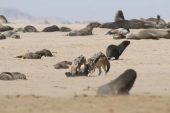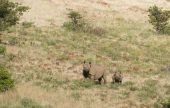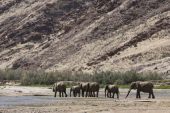Exploring Damaraland and the Skeleton Coast in Namibia
Richard Coke recently guided a safari to the remote north-west of Namibia and has posted a transcript and some photos of what they discovered in this remarkable area…
A country of contrasting and dramatic landscapes that sometimes give you the impression that you are on another planet. It is arguably the oldest Desert in the world, and with an average rainfall of 8mm of rain a year you wonder how living organisms can survive in this harsh environment. For people who have been to the other areas of Africa to see the big game and are looking for an experience so different to anything else, then Namibia is a place that has to be visited.
Our first camp was Damaraland. A huge 65,000ha community area that has been set up as a joint venture between the Torra conservancy and Wilderness Safaris to accommodate guests seeking out to photograph its natural beauty and its flora and fauna. The main attraction being the Desert Elephant. The first day we had a great ele sighting up the Aba-Huab. A small breeding herd of 10 were totally relaxed with us being around them, I which gave us a fantastic opportunity to take some great images of these rare animals. The second day we went out to track the Black Rhino. This was the highlight of our stay here. We found a mother and calf and then we had a second sighting of a cow and a bull. Awesome stuff!
From Damaraland we flew North West to The Skeleton Coast Park, one of the world’s most remote areas. We were staying in a 12 bed Wilderness Camp within a concession of 250,000 Hectares.
On our first full day out we drove North along the coast to one of the only 4 land based Cape Fur Seal colonies in Southern Africa, estimated at 20,000. In mid October bulls pull out onto the beaches to set up and defend territories, a few weeks later the females follow and by late November early December they are giving birth to pups that were conceived last season. 90% of pups are born with in a 30-day period.
We had taken to foot to view these mammals a little closer when we spotted a pair of Black-backed jackals scouting the fringes of the main colony of seals. Black-back jackals are one of the most adaptable and successful of the species. Throughout most of the year they are feeding on small rodents, insects and scavenge what they can from the larger carnivores like the rare Brown Hyena and Desert Lion.
I had read about these cunning creatures feeding on seal pups but was not expecting to sea anything like what we witnessed. We had been viewing the seals for about half an hour when all of a sudden our local guide Gert shouted, they have got one. We turned around and there were these two jackals clinging to a seal pup, shaking it from side to side. This seal pup was noticeably darker and smaller than the rest that were lying around on the beach. It was obviously one of the 10% that was born later. It took only a few minutes for the jackals to kill this pup before they started to feed on it. What we had just witnessed in this unique environment was something quite amazing. And what made it so much more of a special moment was that we were the only 4 of us there.



